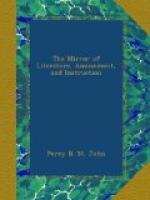Because, as early as the ninth century, it formed an essential part of the education of a young nobleman. Alfred the Great was an expert and successful hunter before he was twelve years of age. Among the tributes imposed by Athelstan, upon a victory over Constantine, King of Wales, were “hawks and sharp-scented dogs, fit for hunting of wild beasts.” Edward the Confessor “took the greatest delight to follow a pack of swift hounds in pursuit of game, and to cheer them with his voice.”—Malmesbury. Harold, his successor, rarely travelled without his hawk and hounds. William the Norman, and his immediate successors, restricted hunting to themselves and their favourites. King John was particularly attached to field sports, and even treated the animals worse than his subjects. In the reign of Edward II. hunting was reduced to a perfect science, and rules established for its practice; these were afterwards extended by the master of the game belonging to Henry IV., and drawn up for the use of his son, Henry Prince of Wales, in two tracts, which are extant. Edward III., according to Froissart, while at war with France, and resident there, had with him sixty couple of stag-hounds, and as many hare-hounds, and every day hunted or hawked. Gaston, Earl of Foix, a foreign nobleman, contemporary with Edward, also kept six hundred dogs in his castle for hunting. James I. preferred hunting to hawking or shooting; so that it was said of him, “he divided his time betwixt his standish, his bottle, and his hunting; the last had his fair weather, the two former his dull and cloudy.”
Ladies’ hunting-dresses of the 15th century, as figured in Strutt’s Sports, &c., differ but little from the modern riding habit.
Why are greyhounds still petted by ladies?
Because in former times they were considered as valuable presents, especially among the ladies, with whom they appear to have been peculiar favourites. In an ancient metrical romance (Sir Eglamore), a princess tells the knight, that if he was inclined to hunt, she would, as an especial mark of her favour, give him an excellent greyhound, so swift that no deer could escape from his pursuit.—Strutt.
Why were certain forests called royal chases?
Because the privileges of hunting there were confined to the king and his favourites; and, to render these receptacles for the beasts of the chase more capacious, or to make new ones, whole villages were depopulated, and places of divine worship overthrown, not the least regard being paid to the miseries of the suffering inhabitants, or the cause of religion.—Strutt.
Why were lands first imparked?
Because their owners might still more effectually preserve deer and other animals for hunting.
A recent French newspaper gave notice of an association for the purpose of enabling persons of all ranks to enjoy the pleasures of the chase. A park of great extent is to be taken on lease near Paris; its extent is about six thousand acres, partly arable, and partly forest ground. The plan is, to open it to subscribers during six months—viz. from September 1 to March 1, an ample stock of game being secured in preserves.




